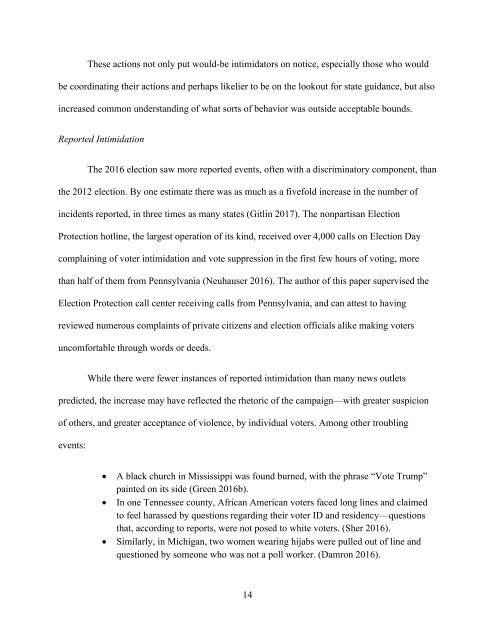Gitlin-Adam
Gitlin-Adam
Gitlin-Adam
You also want an ePaper? Increase the reach of your titles
YUMPU automatically turns print PDFs into web optimized ePapers that Google loves.
These actions not only put would-be intimidators on notice, especially those who would<br />
be coordinating their actions and perhaps likelier to be on the lookout for state guidance, but also<br />
increased common understanding of what sorts of behavior was outside acceptable bounds.<br />
Reported Intimidation<br />
The 2016 election saw more reported events, often with a discriminatory component, than<br />
the 2012 election. By one estimate there was as much as a fivefold increase in the number of<br />
incidents reported, in three times as many states (<strong>Gitlin</strong> 2017). The nonpartisan Election<br />
Protection hotline, the largest operation of its kind, received over 4,000 calls on Election Day<br />
complaining of voter intimidation and vote suppression in the first few hours of voting, more<br />
than half of them from Pennsylvania (Neuhauser 2016). The author of this paper supervised the<br />
Election Protection call center receiving calls from Pennsylvania, and can attest to having<br />
reviewed numerous complaints of private citizens and election officials alike making voters<br />
uncomfortable through words or deeds.<br />
While there were fewer instances of reported intimidation than many news outlets<br />
predicted, the increase may have reflected the rhetoric of the campaign—with greater suspicion<br />
of others, and greater acceptance of violence, by individual voters. Among other troubling<br />
events:<br />
• A black church in Mississippi was found burned, with the phrase “Vote Trump”<br />
painted on its side (Green 2016b).<br />
• In one Tennessee county, African American voters faced long lines and claimed<br />
to feel harassed by questions regarding their voter ID and residency—questions<br />
that, according to reports, were not posed to white voters. (Sher 2016).<br />
• Similarly, in Michigan, two women wearing hijabs were pulled out of line and<br />
questioned by someone who was not a poll worker. (Damron 2016).<br />
14


